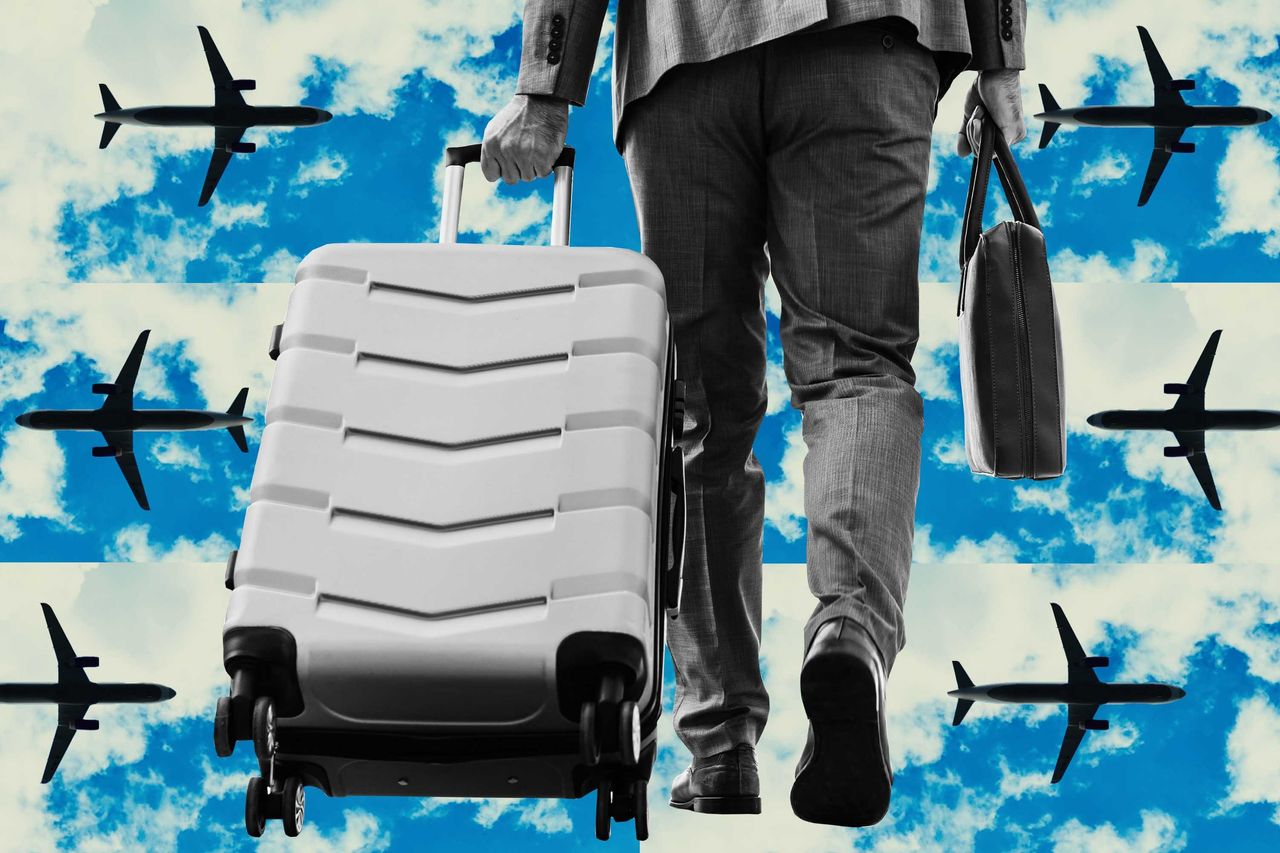I’m a Supercommuter. Here’s What It’s Really Like.
The money, miles and stamina it takes to work in New York and live in Columbus, Ohio
Sometimes I sleep in a different New York City hotel room every night.
On a recent Monday, it was a Midtown Manhattan Hampton Inn. The next night, a budget hotel downtown. Then I moved to a Hyatt in Queens, near John F. Kennedy International Airport, where I waited to check in behind a group of pilots and flight attendants.
The reason for this madness: My job is in New York, but my apartment is in Columbus, Ohio. When hotel prices are high, I property-surf to find a lower rate.
For more than a year, to the bafflement of family, friends and colleagues, I have attempted to live and work as a supercommuter. What began as a postpandemic experiment of flying to and from New York each week has turned into what I am hesitant to call a lifestyle.
Like many, I moved out of the city early in the pandemic, relocating near family in the Midwest. When it came time to return in 2022, I was underwhelmed at the housing options in my price range. I toured one-room studios facing brick walls and climbed crumbling staircases to reach dank apartments with ancient fixtures. I also had grown accustomed to midweek evening walks with my sister in Ohio, and a short drive to see my parents. I didn’t want to fully give that up.
Using back-of-the-envelope math, I thought I could keep my expenses—rent in Ohio, plus travel costs—at or below the price of a nice New York studio, or roughly $3,200 a month. The Wall Street Journal requires office attendance at least three days a week and, since I commute by choice, I pay all my travel expenses.
Luxury suites and room service
The challenge felt oddly thrilling. If anybody could find a way to subvert high New York real-estate costs, while remaining close to family, I thought it might be me. For years, I’ve been an on-call travel guru to friends and co-workers, coaching people on how to navigate flight cancellations and play the credit-card bonus games. I memorise aircraft configurations and spend hours reading mileage blogs and industry sites like Airliners.net.
Before mileage runs became useless, I obsessed over reaching top-tier airline status by spending as little as possible. (Family members still roll their eyes at the six hours I spent in Anchorage one December afternoon to requalify for Delta’s Diamond tier.) When a flight is oversold, I am quick to volunteer my seat in exchange for a voucher. (My best-ever haul: $2,000 after giving up my seat on multiple oversold flights one Saturday in San Francisco.)
Nerding out about this stuff has allowed me to travel farther and in more rarefied air than I could otherwise afford.
Entering my supercommuter era, I had visions of flying to New York on a weekday morning (8,500 points one way on American Airlines), spending the day meeting sources and filing stories, and retiring to one of my favourite points hotels—the Beekman. Mornings would begin with a free breakfast thanks to my Hyatt status, before a short subway ride to the office. After two nights, I’d return to Columbus and my roomy apartment, half the price of a Manhattan studio.
Shocking no one, that fantasy soon came crashing down.
Burning points on fancy hotel rooms was the first problem. The life of a journalist is hard to predict. I repeatedly found myself on deadline and having to rebook flights or stay an extra night, costing me money or miles.
Once I was back in the city, it also got harder to say no. Stay an extra night to attend a friend’s birthday party or meet a CEO in town just for the day? Sign me up. I didn’t want my living situation to strain relationships or interfere with my job, which I love.
To conserve hotel points, I swapped the Beekman’s elegant rooms in lower Manhattan for a Hyatt attached to a casino in Jamaica, Queens. My rooms overlooked a sea of empty parking spaces, but required half as many points as Manhattan alternatives.
Flight delays and blown budgets
By summer, with my miles dwindling and New York hotel rates rising, I reluctantly began to rely on the kindness of those around me. Hearing I might need a place, one friend mailed me the keys to her family’s unoccupied apartment in New Jersey. Another let me stay in her smartly designed Brooklyn one-bedroom for weeks as she traveled. A cherished deskmate, known for her tell-it-like-it-is demeanour, repeatedly offered a bedroom in her Chelsea loft, handing over the keys with a sometimes expletive-tinged reminder to: “Get a f—ing apartment.”
I watered plants, walked friends’ dogs and fed their cats while they were away. Still, working in a city without a permanent home took a toll. I came to dread the go-to question asked at parties and work events in New York: “So where do you live?”

CHIP CUTTER/THE WALL STREET JOURNAL
If I admitted, “it’s kind of complicated,” I got sucked into explaining my life as a supercommuter. Sometimes, I’d just tell people the location of that evening’s hotel. (Chelsea!)
Costs mounted in the fall, New York’s prime tourist and business-travel season. Friends teased me for embracing a life of chaos. They weren’t wrong. Without a refrigerator or stove, late-night dinners often consisted of yogurt and fruit purchased from a 24-hour CVS. Needing to pack light, I stored shoes under my desk and left spare outfits on an office coat rack.
To get to the office on time, I set my alarm in Columbus for 4:15 a.m. and hustled to the airport for 6 a.m. flights. When everything went according to plan, I made it door-to-door in three hours. If delays occurred, I scrambled to rebook on other flights.
My obsessive tracking of New York hotel prices taught me that dynamic pricing isn’t reserved for airlines. Hotel costs can fluctuate half a dozen times on the check-in date, so instead of booking in advance, I’d wait to pull the trigger until 10 p.m. some days after the rates fell.
In the end, the math didn’t work. I blew my budget by 15% and drained my miles balance. But I flew so much and stayed in so many hotels that I kept my elite status with Hyatt and American.
I still enjoy having one foot in the Midwest and one on the East Coast, though I’m not sure how long I can keep it up. I’m writing this from Columbus, where I overlook a beautiful park outside my picture window. My lease is up, but hotel rates in Manhattan this winter have plunged now that the holidays are over. Maybe that New York apartment search can be put off a little longer.
 Copyright 2020, Dow Jones & Company, Inc. All Rights Reserved Worldwide. LEARN MORE
Copyright 2020, Dow Jones & Company, Inc. All Rights Reserved Worldwide. LEARN MORE
Records keep falling in 2025 as harbourfront, beachfront and blue-chip estates crowd the top of the market.
A divide has opened in the tech job market between those with artificial-intelligence skills and everyone else.
JPMorgan Chase has a ‘strong bias’ against adding staff, while Walmart is keeping its head count flat. Major employers are in a new, ultra lean era.
It’s the corporate gamble of the moment: Can you run a company, increasing sales and juicing profits, without adding people?
American employers are increasingly making the calculation that they can keep the size of their teams flat—or shrink through layoffs—without harming their businesses.
Part of that thinking is the belief that artificial intelligence will be used to pick up some of the slack and automate more processes. Companies are also hesitant to make any moves in an economy many still describe as uncertain.
JPMorgan Chase’s chief financial officer told investors recently that the bank now has a “very strong bias against having the reflective response” to hire more people for any given need. Aerospace and defense company RTX boasted last week that its sales rose even without adding employees.
Goldman Sachs , meanwhile, sent a memo to staffers this month saying the firm “will constrain head count growth through the end of the year” and reduce roles that could be more efficient with AI. Walmart , the nation’s largest private employer, also said it plans to keep its head count roughly flat over the next three years, even as its sales grow.
“If people are getting more productive, you don’t need to hire more people,” Brian Chesky , Airbnb’s chief executive, said in an interview. “I see a lot of companies pre-emptively holding the line, forecasting and hoping that they can have smaller workforces.”
Airbnb employs around 7,000 people, and Chesky says he doesn’t expect that number to grow much over the next year. With the help of AI, he said he hopes that “the team we already have can get considerably more work done.”
Many companies seem intent on embracing a new, ultralean model of staffing, one where more roles are kept unfilled and hiring is treated as a last resort. At Intuit , every time a job comes open, managers are pushed to justify why they need to backfill it, said Sandeep Aujla , the company’s chief financial officer. The new rigor around hiring helps combat corporate bloat.
“That typical behavior that settles in—and we’re all guilty of it—is, historically, if someone leaves, if Jane Doe leaves, I’ve got to backfill Jane,” Aujla said in an interview. Now, when someone quits, the company asks: “Is there an opportunity for us to rethink how we staff?”
Intuit has chosen not to replace certain roles in its finance, legal and customer-support functions, he said. In its last fiscal year, the company’s revenue rose 16% even as its head count stayed flat, and it is planning only modest hiring in the current year.
The desire to avoid hiring or filling jobs reflects a growing push among executives to see a return on their AI spending. On earnings calls, mentions of ROI and AI investments are increasing, according to an analysis by AlphaSense, reflecting heightened interest from analysts and investors that companies make good on the millions they are pouring into AI.
Many executives hope that software coding assistants and armies of digital agents will keep improving—even if the current results still at times leave something to be desired.
The widespread caution in hiring now is frustrating job seekers and leading many employees within organizations to feel stuck in place, unable to ascend or take on new roles, workers and bosses say.
Inside many large companies, HR chiefs also say it is becoming increasingly difficult to predict just how many employees will be needed as technology takes on more of the work.
Some employers seem to think that fewer employees will actually improve operations.
Meta Platforms this past week said it is cutting 600 jobs in its AI division, a move some leaders hailed as a way to cut down on bureaucracy.
“By reducing the size of our team, fewer conversations will be required to make a decision, and each person will be more load-bearing and have more scope and impact,” Alexandr Wang , Meta’s chief AI officer, wrote in a memo to staff seen by The Wall Street Journal.
Though layoffs haven’t been widespread through the economy, some companies are making cuts. Target on Thursday said it would cut about 1,000 corporate employees, and close another 800 open positions, totaling around 8% of its corporate workforce. Michael Fiddelke , Target’s incoming CEO, said in a memo sent to staff that too “many layers and overlapping work have slowed decisions, making it harder to bring ideas to life.”
A range of other employers, from the electric-truck maker Rivian to cable and broadband provider Charter Communications , have announced their own staff cuts in recent weeks, too.
Operating with fewer people can still pose risks for companies by straining existing staffers or hurting efforts to develop future leaders, executives and economists say. “It’s a bit of a double-edged sword,” said Matthew Martin , senior U.S. economist at Oxford Economics. “You want to keep your head count costs down now—but you also have to have an eye on the future.”
With two waterfronts, bushland surrounds and a $35 million price tag, this Belongil Beach retreat could become Byron’s most expensive home ever.
A divide has opened in the tech job market between those with artificial-intelligence skills and everyone else.






















